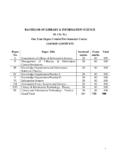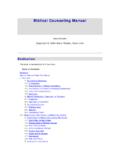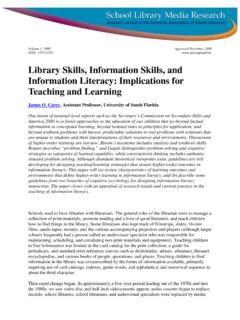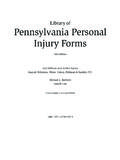Transcription of THE COMMON LAW - general-intelligence.com
1 THECOMMONLAWO liver Wendell Holmes, byPaulo J. S. Pereira&Diego M. BeltranUniversity of Toronto Law SchoolTypographical SocietySeptember43,4233 Paulo J. S. Pereira&Diego M. Beltran, MMXIThe text of this work is based on the3::3edition of OliverWendell Holmes, which is now in the public domain. The typog-raphy and formatting are licensed under theCreative send corrections and comments Forms of Liability74 The Criminal Law5:5 Torts. Trespass and Negligence936 Fraud, Malice, and Intent. The Theory of Torts3397 The Bailee at COMMON Law3688 Possession3:59 Contract. I. History43;:Contract. II. Elements478;Contract. III. Void and Voidable49432 Successions I. After Death II. Inter Vivos52233 Successions. II. Inter Vivos549 Index583prefaceThisis written in pursuance of a plan which I have long hadin mind. I had taken a first step in publishing a numberof articles in the American Law Review, but I should hardlyhave attempted the task of writing a connected treatise at thepresent time, had it not been for the intention to deliver a courseof Lectures at the Lowell Institute in Boston.
2 That invitationencouraged me to do what was in my power to accomplish mywish. The necessity of preparing for the Lectures made it easierto go farther, and to prepare for printing, and accordingly I didso. I have made such use as I thought fit of my articles in theLaw Review, but much of what has been taken from that sourcehas been rearranged, rewritten, and enlarged, and the greaterpart of the work is new. The Lectures as actually delivered werea good deal simplified, and were twelve in number. The twelfth,however, was a summary of the foregoing eleven, and has beenomitted as not necessary for a reader with the book before limits of such an undertaking as the present must neces-sarily be more or less arbitrary. Those to which I have confinedmyself have been fixed in part by the limits of the course forwhich the Lecgures were written. I have therefore not attemptedto deal with Equity, and have even excluded those subjects likeBills and Notes, or Partnership, which would naturally requirean isolated treatment, and which do not promise to throw lighton general theory.
3 If, within the bounds which I have set myself,any one should feel inclined to reproach me for a want of greaterdetail, I can only quote the words of Lehu rou, Nous faisons uneth orie et non un spicil ge. O. W. Holmes, ,February:,3 forms of liabilityTheobject of this book is to present a general view of theObject of theBookCommon Law. To accomplish the task, other tools are neededbesides logic. It is something to show that the consistency of asystem requires a particular result, but it is not all. The life of thelaw has not been logic: it has been experience. The felt necessitiesof the time, the prevalent moral and political theories, intuitionsof public policy, avowed or unconscious, even the prejudices whichjudges share with their fellow-men, have had a good deal moreto do than the syllogism in determining the rules by which menshould be governed. The law embodies the story of a nation sdevelopment through many centuries, and it cannot be dealt withas if it contained only the axioms and corollaries of a book ofmathematics.
4 In order to know what it is, we must know whatit has been, and what it tends to become. We must alternatelyconsult history and existing theories of legislation. But the mostdifficult labor will be to understand the combination of the twointo new products at every stage. The substance of the law at anygiven time pretty nearly corresponds, so far as it goes, with whatis then understood to be convenient; but its form and machinery,and the degree to which it is able to work out desired results,depend very much upon its Massachusetts to-day, while, on the one hand, there area great many rules which are quite sufficiently accounted for bytheir manifest good sense, on the other, there are some whichcan only be understood by reference to the infancy of procedureamong the German tribes, or to the social condition of Romeunder the shall use the history of our law so far as it is necessaryto explain a conception or to interpret a rule, but no doing so there are two errors equally to be avoided both bywriter and reader.
5 One is that of supposing, because an idea7 EARLY FORMS OF LIABILITY seems very familiar and natural to us, that it has always been things which we take for granted have had to be laboriouslyfought out or thought out in past times. The other mistake isthe opposite one of asking too much of history. We start withman full grown. It may be assumed that the earliest barbarianwhose practices are to be considered, had a good many of thesame feelings and passions as subject to be discussed is the general theory of liabilityThe Origin ofLegal Procedurein the Com-position forVengeancecivil and criminal. The COMMON Law has changed a good dealsince the beginning of our series of reports, and the search aftera theory which may now be said to prevail is very much a studyof tendencies. I believe that it will be instructive to go back tothe early forms of liability, and to start from of Legal Procedure in the Composition for VengeanceIt is commonly known that the early forms of legal procedurewere grounded in vengeance.
6 Modern writers have thought thatthe Roman law started from the blood feud, and all the authoritiesagree that the German law begun in that way. The feud led to thecomposition, at first optional, then compulsory, by which the feudwas bought off. The gradual encroachment of the compositionmay be traced in the Anglo-Saxon laws,3and the feud was prettywell broken up, though not extinguished, by the time of Williamthe Conqueror. The killings and house-burnings of an earlier daybecame the appeals of mayhem and arson. The appealsde paceet plagisand of mayhem became, or rather were in substance,the action of trespass which is still familiar to the compensation recovered in the appeal was the alternativeof vengeance, we might expect to find its scope limited to thescope of vengeance. Vengeance imports a feeling of blame, and anopinion, however distorted by passion, that a wrong has been Ine, ; Alfred, ; Ethelred, , , ,367; Fleta, I.
7 ,63; Co. ;333 Hawkins, , , , 37. P. J. S. Pereira&D. M. Beltran, MMXI8 EARLY FORMS OF LIABILITYIt can hardly go very far beyond the case of a harm intentionallyinflicted: even a dog distinguishes between being stumbled overand being for this cause or another, the early English appealsfor personal violence seem to have been confined to intentionalwrongs. Glanvill5mentions m l es, blows, and wounds, allforms of intentional violence. In the fuller description of suchappeals given by Bracton6it is made quite clear that they werebased on intentional assaults. The appealde pace et plagislaidan intentional assault, described the nature of the arms used,and the length and depth of the wound. The appellor also hadto show that he immediately raised the hue and cry. So whenBracton speaks of the lesser offences, which were not sued by wayof appeal, he instances only intentional wrongs, such as blows withthe fist, flogging, wounding, insults, and so cause ofaction in the cases of trespass reported in the earlier Year Booksand in theAbbreviatio Placitorumis always an intentional was only at a later day, and after argument, that trespasswas extended so as to embrace harms which were foreseen, butwhich were not the intended consequence of the defendant s again it extended to unforeseen will be seen that this order of development is not quiteconsistent with an opinion which has been held, that it was acharacteristic of early law not to penetrate beyond the externalvisible fact, thedamnum corpore corpori datum.
8 It has beenthought that an inquiry into the internal condition of the defen-dant, his culpability or innocence, implies a refinement of juridicalconception equally foreign to Rome before the Lex Aquilia, andto England when trespass took its shape. I do not know any very5 Lib. I. ,ad , , assulto pr meditato. ; , :.9 Ibid., and43H. , P. J. S. Pereira&D. M. Beltran, MMXI9 EARLY FORMS OF LIABILITY satisfactory evidence that a man was generally held liable eitherin Rome:or England for the accidental consequences even of hisown act. But whatever may have been the early law, the foregoingaccount shows the starting-point of the system with which wehave to deal. Our system of private liability for the consequencesof a man s own acts, that is, for his trespasses, started from thenotion of actual intent and actual personal principles of liability for harm inflicted by anotherSubject of thisLecture, Indi-rect Liability forServants, Ani-mals, & or thing have been less carefully considered hitherto thanthose which governed trespass, and I shall therefore devote therest of this Lecture to discussing them.
9 I shall try to show thatthis liability also had its root in the passion of revenge, and topoint out the changes by which it reached its present form. But Ishall not confine myself strictly to what is needful for that purpose,because it is not only most interesting to trace the transformationthroughout its whole extent, but the story will also afford aninstructive example of the mode in which the law has grown,without a break, from barbarism to civilization. Furthermore, itwill throw much light upon some important and peculiar doctrineswhich cannot be returned to very COMMON phenomenon, and one very familiar to thestudent of history, is this. The customs, beliefs, or needs of aprimitive time establish a rule or a formula. In the course ofcenturies the custom, belief, or necessity disappears, but therule remains. The reason which gave rise to the rule has beenforgotten, and ingenious minds set themselves to inquire how it isto be accounted for.
10 Some ground of policy is thought of, whichseems to explain it and to reconcile it with the present state ofthings; and then the rule adapts itself to the new reasons whichhave been found for it, and enters on a new career. The oldform receives a new content, and in time even the form ;.;. P. J. S. Pereira&D. M. Beltran, MMXI:EARLY FORMS OF LIABILITY itself to fit the meaning which it has received. The subject underconsideration illustrates this course of events very will begin by taking a medley of examples embodying asmany distinct rules, each with its plausible and seemingly sufficientground of policy to explain man has an animal of known ferocious habits, which escapesand does his neighbor damage. He can prove that the animalescaped through no negligence of his, but still he is held It is, says the analytical jurist, because, although he wasnot negligent at the moment of escape, he was guilty of remoteheedlessness, or negligence, or fault, in having such a creature atall.








